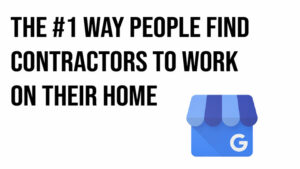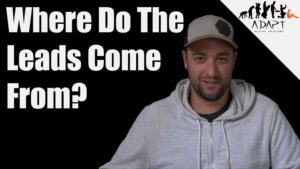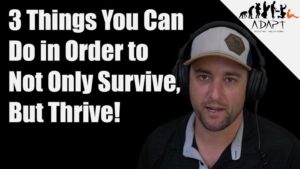“Hard times create strong men,
strong men create good times,
good times create weak men,
and weak men create hard times.” – G. Michael Hopf
Times have been really good for a long time. With everything going on in the world, it looks like the cycle is moving into the “hard” territory. You can’t turn on the news without hearing the word “recession” about 100 times. With that said, I believe there is always an opportunity for those that are willing to work hard for it.
If you ask any financial advisor where to put your money, they will tell you to diversify your portfolio. Diversification reduces the risk of losing all your money should any one investment go bust. Diversification is a strategy as old as time.
As an investment in your business, the same principle applies to your marketing strategy. The majority of local business owners don’t pay much attention to their marketing, so it comes as no surprise that most are not diversified in the ways they acquire new customers. They usually don’t even think about it until the phone calls slow down or stop entirely. Is this you? If so, this article is definitely for you.
First off, let’s define the term marketing as I’m using it in this article.
Marketing is any action or investment intended to result in acquiring new customers in the future.
I still remember the day I “Googled” the word marketing. It was 2016, 8 years after I should have learned this lesson. I say that because at the beginning of the 2008 recession my family’s construction business hit a brick wall when the phone stopped ringing. We had been relying on 2 sources of new customers:
- Referrals and repeat customers – 70%
- Contracts from the local Lowes store to install cabinets – 30%
When the housing crisis hit, the phone calls went from a few a week to zero. After about four weeks we began to worry. We were lucky that a national bank contracted us to clean out and maintain foreclosed homes in our area. Lord knows there were a ton of them… It didn’t pay much but it paid the bills. Reminiscing with my dad, he always says, “We didn’t save any money but we paid all the bills and kept food on the table.” That went on for about two years.
What would have happened if that bank hadn’t come along and given us work? I’m sure we would have found a way to survive but it would have been tough. Next time it happens, I’ll be much better prepared. How so? By having multiple marketing channels that bring in new customers.
Currently, we are bringing in a lot more opportunities than we can handle, and should the situation arise where there are 75% fewer people searching for professionals like us, we’ll still have enough coming in to keep the train moving forward. Here are some things I’m doing now that I hope will help us survive and thrive as the times get harder.
Organic Customers: The Ones That Find Us On Their Own
Anyone can pay an ad agency to run advertisements but I prefer it when customers find me on their own. They do this in a few ways:
- They find our website on search engines like Google, Bing, Yahoo, Etc. – 20%
- They see us on Google Maps where we have reviews, pictures, contact information, etc. – 50%
- They get referred to us by past clients and other professionals we work with. – 25%
- They see our signs, t-shirts, etc. around town. – 5%
The biggest change for us since 2008 is our online presence. It was in 2010 that we finally “got with the times” and built a website for our company. The effects were noticeable immediately. Back then, we were one of the few contractors in our area that even had a website and, to our surprise, a lot of people were using Google to find local services. The number of folks using Google has increased to 90%+ and these days it’s Google Maps that people use most to find local businesses.
Here we are 12 years later and our online channels are still bringing in more opportunities than we can handle. Even so, we still try to stay sharp on our strategies for paid customer acquisition. So, what do I mean by paid customer acquisition?
Paid Customers: The Ones That Respond to Advertisements
Anyone can give some money to Google and have their ads showing in a few hours. They call these CPC ads or Cost-per-click. That means you pay Google every time someone clicks on your ad. The average success rate of an ad is 3.5%. This means that if you pay for 100 clicks, you’re likely to get 3-4 inquiries from possible customers. How much does it cost for a click?
I’ve seen clicks range from $1 to $300+. Usually, I see them between $10 – $50 for local services. Let’s go with the low end for this example: $10 per click.
Let’s say you buy 100 clicks for $10 a piece, that’s $1000. If you get 4 inquiries, you’re paying $250 per inquiry. An inquiry can be a phone call, contact form from your website, email, etc.
Now, let’s say you get 25% of those inquiries to become paying customers. This percentage is usually lower with advertising due to tire kickers, spam, etc. but for the sake of this example let’s go with 25%. The math is simple: $1000 = 1 customer.
In my businesses, it’s not ideal to pay $1000 to get a job, but if I have to, I can make it work. I might have to charge a little more and/or sacrifice some profit, but it’s a lot better than nothing! I only use this marketing method when I have to, which hasn’t been for a few years. Since I have done it before, I know how it works and can easily start advertising with the flick of a switch. Have you successfully advertised before? If so, what were the results?
A Good Marketing Strategy Starts With Measuring
“That which gets measured gets managed.” – Peter Drucker
The first step to diversifying your sources of new customers is figuring out where they’re coming from now. Do you track these details?
I can look back at the last 50 customers and tell you where each one came from. This allows me to see what channels are fueling my business now so that I can make adjustments to the time and resources I dedicate to marketing. I want to be diversified so that if one channel dries up, I have others to fall back on.
I would argue that these metrics are just as important as understanding your finances. You track where your money goes and the return you get on your investments elsewhere, so why not track where your new customers come from? After all, they are the ones that sign your checks.
Online Marketing: The Low Hanging Fruit in the Groundwater Industry
For most of the companies I’ve come across in groundwater, online marketing is the lowest hanging fruit. Still, the majority of folks I talk to have not spent much time getting their business online. This has resulted in enormous opportunities for those that can be bothered to do so. Just like my family’s business back in 2010, a lot of gains can be made for those who are willing to get established with a good website and a Google Listing.
Most of my clients in the groundwater industry are as busy as they can be, at least they have been for the last few years. There are other problems to worry about such as how to charge higher rates and find people to complete the jobs. The thing about marketing is that by the time it’s a problem, it’s already too late. Those who are proactive about diversifying their marketing strategy now are more likely to avoid a desperate situation later. Rushing things is a costly endeavor.
Where Do We Go From Here?
What can you do to diversify your marketing strategy and lower your risk of ending up in a desperate situation? Here’s a short checklist of things that can help:
- Go back and figure out where the last 25 customers came from and identify the marketing channels you currently have working for you.
- Make sure that you have a Google My Business (Google Maps) listing and that you’re getting reviews regularly. It’s free to sign up at google.com/business.
- Assess your website and determine if it’s up to par. A good test of this is to ask yourself honestly, “Am I proud to show off my website?”.
- Learn how to get customers through paid means even if you don’t need them so that you know what to do when you do need them.
- Get together with others in your community and talk about how you can help each other when times get tougher.
I hope this article is helpful for you. If you have any questions or need a hand with this stuff, you can reach me at chuck@adaptdigitalsolutions.com. My company specializes in marketing for local service businesses such as well drillers and pump contractors so we live this stuff day in and day out. Also, if you have any feedback, I would love to hear it. Thanks for reading.































